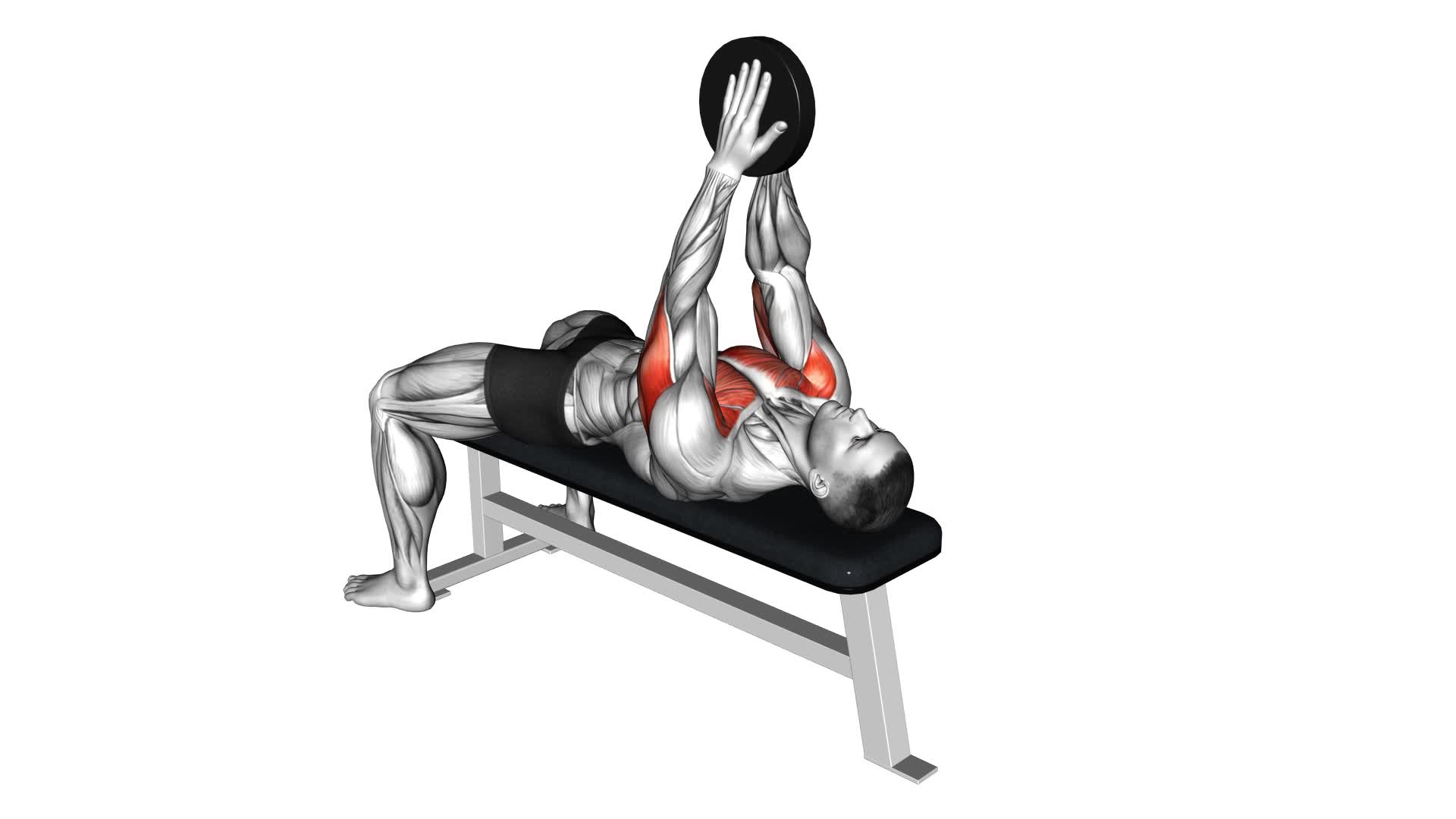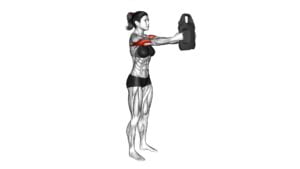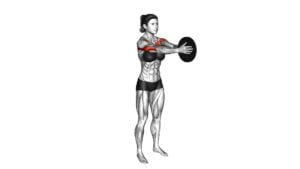Weighted Svend Bench Press – Video Exercise Guide & Tips

Are you looking to strengthen your upper body and build muscle?
Watch This Exercise Video
The Weighted Svend Bench Press is a fantastic exercise that targets your chest, shoulders, and triceps.
In this video exercise guide, you'll learn the proper form and technique for maximum effectiveness.
We'll also provide tips on choosing the right weight and equipment, as well as common mistakes to avoid.
Get ready to increase your strength and take your fitness to the next level with this challenging workout.
Key Takeaways
- Weighted Svend Bench Press increases upper body strength and muscle growth.
- The exercise targets the chest, shoulders, and triceps.
- Proper form and technique involve maintaining a stable core and keeping the weights together in front of the chest.
- Choosing the right weight and equipment is crucial for effective targeting of the chest muscles.
Benefits of the Weighted Svend Bench Press
You will experience increased upper body strength and muscle growth when you incorporate the weighted Svend bench press into your workout routine. This exercise specifically targets your chest, shoulders, and triceps, helping you to build and define these muscles. The weighted Svend bench press requires you to hold a pair of dumbbells or weighted plates together in front of your chest while performing the bench press movement. This added resistance increases the muscle activation in your upper body, leading to greater strength gains and muscle growth.
One of the key benefits of the weighted Svend bench press is its ability to improve stability and balance. By holding the weights together, you're required to engage your core muscles to maintain proper form and balance throughout the exercise. This not only strengthens your core but also enhances your overall stability, which can be beneficial in other lifts and everyday activities.
In addition to increased muscle activation and improved stability, the weighted Svend bench press offers a variation to the traditional bench press that can help prevent muscle imbalances. By bringing the weights together, you promote a more symmetrical movement, ensuring that both sides of your body are working equally. This can help to correct any imbalances and prevent injuries.
Incorporating the weighted Svend bench press into your workout routine can provide you with a challenging exercise that targets your upper body muscles while improving stability and balance.
Proper Form and Technique for the Exercise
To perform the weighted Svend bench press with proper form and technique, focus on maintaining a stable core and keeping the weights together in front of your chest throughout the exercise. Contrary to common misconceptions, the weighted Svend bench press primarily targets the pectoralis major, deltoids, and triceps, with secondary activation of the biceps and core muscles.
Start by lying flat on a bench with your feet planted firmly on the ground. Grasp two dumbbells or weight plates together with your palms facing each other. Position the weights directly in front of your chest, ensuring they remain close together throughout the movement. This position maximizes muscle activation in the chest and shoulders.
Lower the weights slowly and under control towards your chest, maintaining a slight bend in the elbows. Avoid bouncing or using excessive momentum. Pause briefly at the bottom before pushing the weights back up to the starting position, fully extending your arms without locking out the elbows.
Throughout the exercise, engage your core muscles to maintain stability and prevent excessive arching of the back. Focus on squeezing your chest muscles as you push the weights back up.
Choosing the Right Weight and Equipment
When selecting the appropriate weight and equipment for the weighted Svend bench press, consider your current strength level and choose dumbbells or weight plates that challenge you without compromising proper form.
The weight selection is crucial in ensuring that you get the most out of this exercise. If the weight is too light, you won't effectively target your chest muscles. On the other hand, if the weight is too heavy, you risk straining your muscles and potentially injuring yourself. It's important to find the right balance.
For the weighted Svend bench press, you have two main equipment options: dumbbells or weight plates. Dumbbells allow for a greater range of motion and provide a more challenging workout. They also help to improve stability and balance. On the other hand, weight plates can be easily adjusted to increase or decrease the weight as needed. Whichever option you choose, make sure it's comfortable for you to hold and control during the exercise.
Now that you understand the importance of weight selection and the equipment options available, let's move on to the next section and discuss common mistakes to avoid.
Common Mistakes to Avoid
One common mistake to avoid during the weighted Svend bench press is using too much weight. While it might be tempting to go heavy right from the start, it's important to prioritize proper technique over the amount of weight lifted. Using too much weight can lead to compromising form, which increases the risk of injury and diminishes the effectiveness of the exercise.
Another common mistake isn't maintaining a stable core throughout the movement. Your core muscles play a crucial role in stabilizing your body during the bench press. Failing to engage and activate your core can lead to instability and poor form, reducing the effectiveness of the exercise and increasing the risk of injury.
Additionally, rushing through the exercise is a mistake to avoid. It's important to perform each repetition with control and focus. This allows you to fully engage the target muscles and maximize the benefits of the exercise. Rushing through the movement not only compromises form but also reduces the effectiveness of the exercise.
Lastly, improper grip width is a common mistake to watch out for. A wider grip can put unnecessary strain on the shoulders, while a narrower grip may limit the activation of the chest muscles. Finding the right grip width that suits your body mechanics is essential for proper form and optimal muscle engagement.
Tips to Increase Strength and Progression
To increase your strength and progress in the weighted Svend bench press, it's important to focus on proper form. Make sure you maintain a stable and controlled movement throughout the exercise.
Additionally, implementing progressive overload techniques, such as increasing weight or reps gradually, can help challenge your muscles and promote strength gains.
Lastly, don't overlook the importance of rest and recovery, as giving your body time to repair and rebuild is essential for progress.
Proper Form Importance
To increase your strength and progression in the Weighted Svend Bench Press, it's essential that you prioritize proper form. The importance of technique can't be overstated, as it not only maximizes your gains but also prevents injuries.
Maintaining the correct posture and alignment throughout the exercise ensures that you're targeting the intended muscles effectively. It also helps distribute the load evenly, reducing the risk of strain or sprain. Focusing on proper form also allows you to engage your core and stabilizer muscles, enhancing overall strength and stability.
Remember to start with lighter weights and gradually increase the load as you become more comfortable with the exercise. Prioritizing proper form won't only help you achieve your strength goals but also keep you safe and injury-free.
Progressive Overload Techniques
To increase your strength and progression in the Weighted Svend Bench Press, incorporate progressive overload techniques into your training routine. Progressive overload is the concept of gradually increasing the demands on your muscles over time, forcing them to adapt and grow stronger.
One way to achieve this is by increasing the training frequency of your Weighted Svend Bench Press sessions. Instead of only performing the exercise once a week, try incorporating it into your routine two or three times a week.
Another important aspect of progressive overload is exercise selection. In addition to the Weighted Svend Bench Press, include other compound exercises that target the chest, shoulders, and triceps to further stimulate muscle growth and overall strength.
By implementing these progressive overload techniques, you can maximize your results and continually challenge your muscles for optimal progression.
Now, let's move on to discussing rest and recovery strategies.
Rest and Recovery Strategies
To increase your strength and progression in the Weighted Svend Bench Press, it's essential to prioritize rest and recovery strategies.
Implementing proper recovery methods is crucial for injury prevention and overall performance improvement. After intense training sessions, allow yourself enough time to rest and recover.
This includes getting enough sleep, as it plays a vital role in muscle repair and growth. Additionally, incorporating active recovery exercises such as foam rolling and stretching can help alleviate muscle soreness and improve flexibility.
It's also important to fuel your body with the right nutrients, including protein and carbohydrates, to support muscle recovery and replenish energy stores.
Variations and Modifications for Different Fitness Levels
Choose the appropriate variation of the weighted Svend Bench Press based on your fitness level. There are several modifications and variations you can make to this exercise to suit your individual needs and goals.
If you're a beginner or have limited strength, you can start with lighter weights or no weights at all. This will allow you to focus on mastering the correct form and technique before gradually increasing the weight. As you progress, you can gradually add more weight to challenge your muscles and increase the intensity of the exercise.
For intermediate fitness levels, you can use moderate to heavy weights to further challenge your muscles. This will help you build strength and increase muscle mass. You can also experiment with different hand positions and grip widths to target different muscle groups.
Advanced fitness levels can incorporate advanced variations of the weighted Svend Bench Press, such as using resistance bands or performing the exercise on an unstable surface like a stability ball. These variations will engage more muscles and increase the difficulty of the exercise.
Remember to always listen to your body and adjust the weight and variations accordingly. It's important to challenge yourself, but also to prioritize safety and proper form. Consulting with a fitness professional can also provide guidance on the best modifications and variations for your specific fitness level and goals.
Frequently Asked Questions
How Many Sets and Reps Should I Do for the Weighted Svend Bench Press?
For the weighted Svend bench press, it's recommended to start with 3 sets of 8-12 reps. This will help you build strength and muscle endurance. However, it's important to listen to your body and adjust the sets and reps based on your fitness level and goals.
You can also try variations of the Svend bench press, such as using different grip widths or changing the angle of the bench, to target different muscles and keep your workouts challenging.
Can I Do the Weighted Svend Bench Press if I Have a Shoulder Injury?
If you have a shoulder injury, it's important to be cautious with the Weighted Svend Bench Press. While it can be effective for building strength, it may put too much strain on your shoulder.
Instead, consider variations of the exercise that don't aggravate your injury, such as using lighter weights or resistance bands.
Additionally, focus on shoulder rehabilitation exercises recommended by a healthcare professional to promote healing and prevent further injury.
Is It Necessary to Have a Spotter While Performing the Weighted Svend Bench Press?
It's important to have a spotter when doing the weighted Svend bench press. They can help ensure your safety and provide assistance if needed.
If you don't have a spotter, you can try alternative exercises that don't require one, such as dumbbell chest presses or push-ups.
However, having a spotter is highly recommended, especially when lifting heavier weights.
Always prioritize safety when performing any exercise.
Can the Weighted Svend Bench Press Help in Improving My Bench Press Strength?
The weighted Svend bench press is a bench press variation that can help improve your bench press strength. By adding weight to the exercise, you increase the resistance and challenge your muscles even more. This can lead to increased muscle growth and strength in your chest, shoulders, and triceps.
The Svend bench press also engages your core and stabilizer muscles, enhancing overall stability and balance. Incorporating this exercise into your routine can benefit your bench press and overall upper body strength.
Are There Any Specific Warm-Up Exercises That I Should Perform Before Doing the Weighted Svend Bench Press?
Before performing the weighted Svend bench press, it's important to warm up properly to prepare your muscles for the exercise. Engaging in specific warm-up exercises can help prevent injury and optimize your performance.
The weighted Svend bench press offers numerous benefits, such as increasing upper body strength, improving muscle endurance, and enhancing overall bench press performance. Incorporating this exercise into your routine can help you achieve your fitness goals more effectively.
Conclusion
In conclusion, the weighted Svend bench press is a beneficial exercise for increasing strength and muscle development. By using proper form and technique, choosing the right weight and equipment, and avoiding common mistakes, individuals can maximize the effectiveness of this exercise.
Additionally, incorporating variations and modifications can cater to different fitness levels and help individuals progress in their fitness journey.
Overall, the weighted Svend bench press is a valuable addition to any workout routine.

Author
Years ago, the spark of my life’s passion ignited in my mind the moment I stepped into the local gym for the first time. The inaugural bead of perspiration, the initial endeavor, the very first surge of endorphins, and a sense of pride that washed over me post-workout marked the beginning of my deep-seated interest in strength sports, fitness, and sports nutrition. This very curiosity blossomed rapidly into a profound fascination, propelling me to earn a Master’s degree in Physical Education from the Academy of Physical Education in Krakow, followed by a Sports Manager diploma from the Jagiellonian University. My journey of growth led me to gain more specialized qualifications, such as being a certified personal trainer with a focus on sports dietetics, a lifeguard, and an instructor for wellness and corrective gymnastics. Theoretical knowledge paired seamlessly with practical experience, reinforcing my belief that the transformation of individuals under my guidance was also a reflection of my personal growth. This belief holds true even today. Each day, I strive to push the boundaries and explore new realms. These realms gently elevate me to greater heights. The unique combination of passion for my field and the continuous quest for growth fuels my drive to break new ground.







